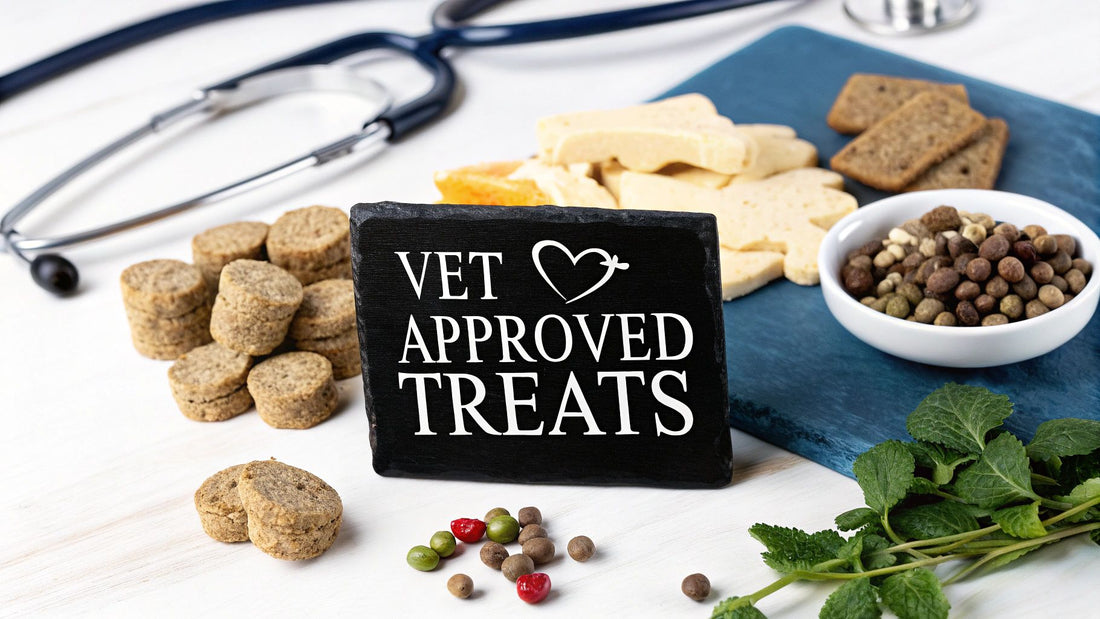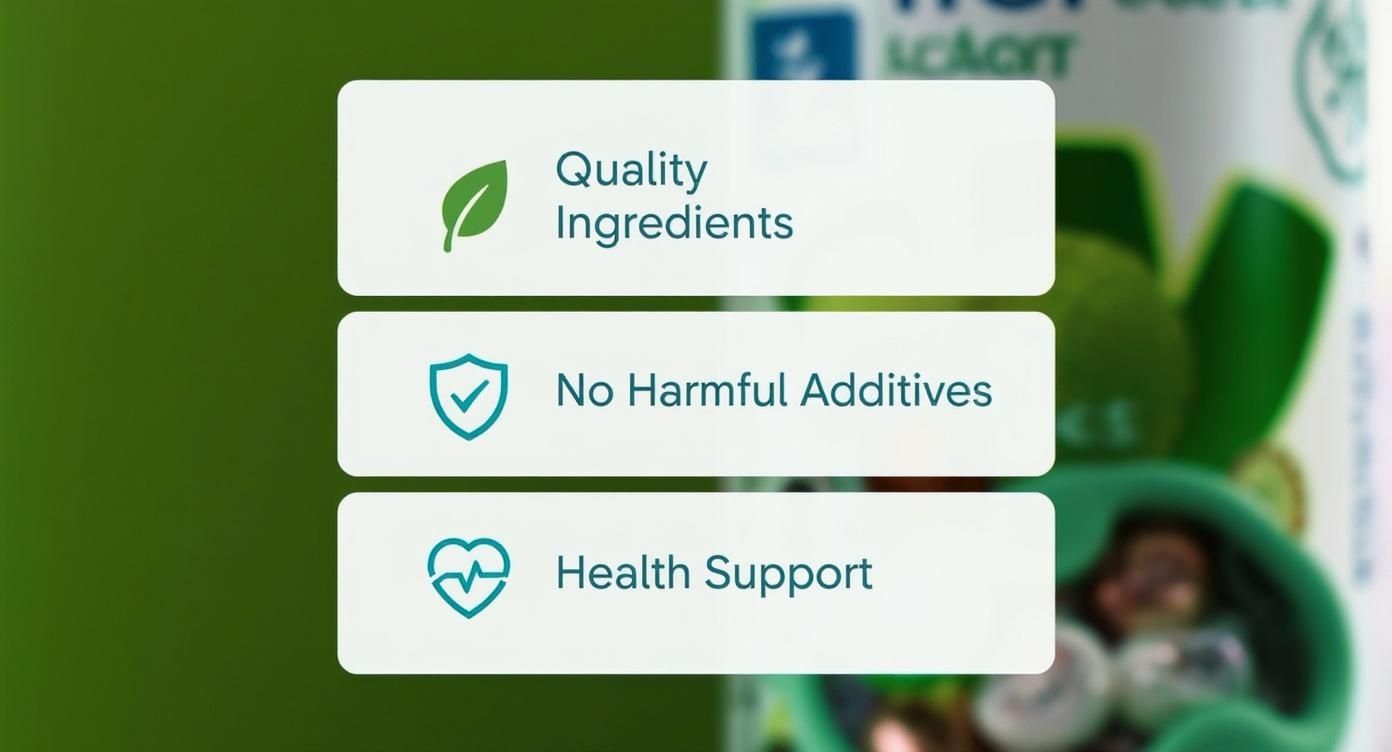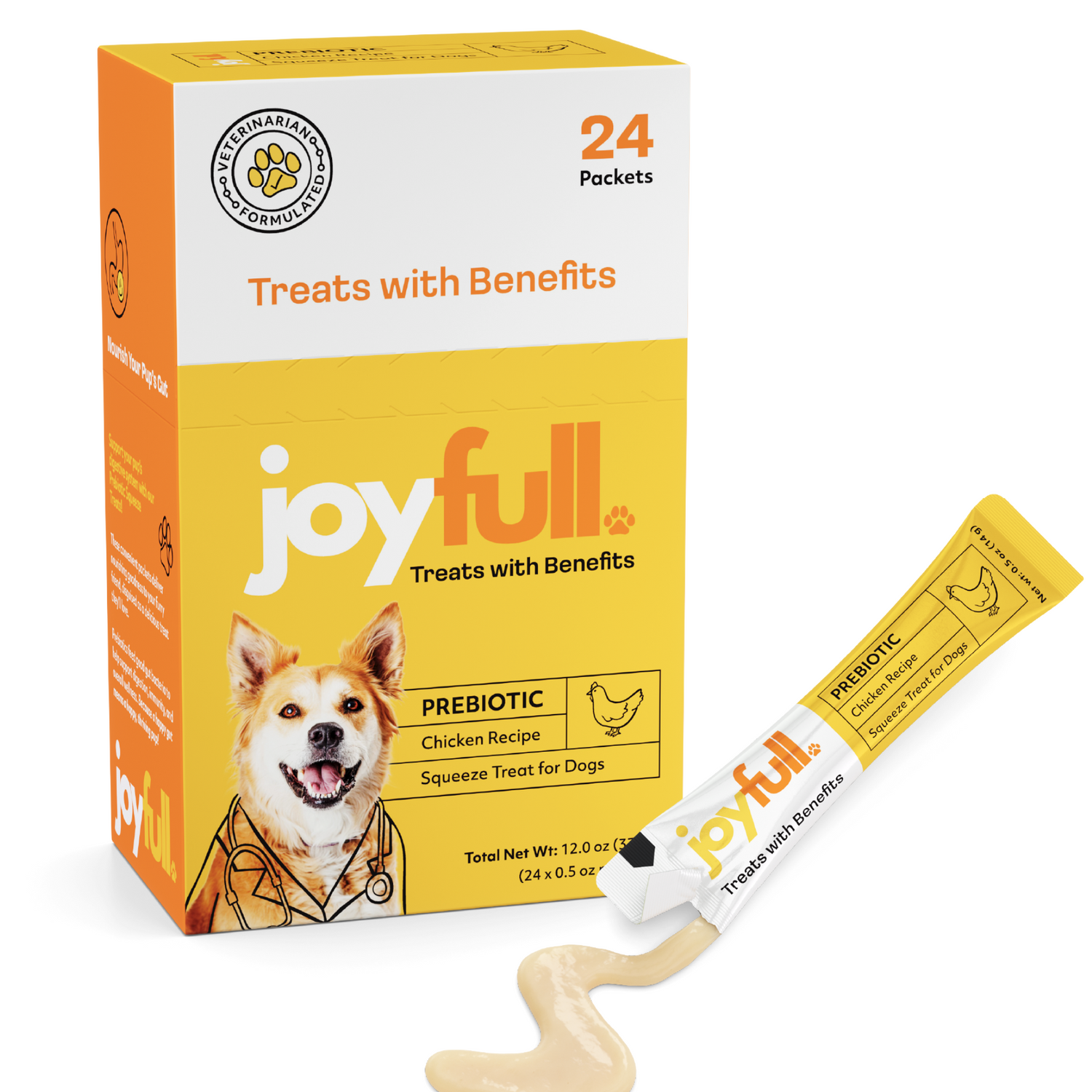
A Guide to Vet Approved Dog Treats
You've probably seen the phrase "vet-approved dog treats" on packaging and wondered what it really means. It sounds official, like it has some kind of stamp from a veterinary board, but that's not quite the case.
Think of it less as a formal certification and more as a strong hint. It's a marketing term, yes, but it’s one that signals the product was created with a veterinarian's priorities in mind: think high-quality nutrition, safe ingredients, and genuine health benefits for your dog.
What Vet Approved Dog Treats Actually Means
When a brand labels their treats "vet-approved," they're trying to tell you they've skipped the flashy gimmicks and cheap fillers. The idea is to make your choice easier, pointing you toward a treat that's genuinely good for your dog.
This whole trend comes from a simple, wonderful shift: we see our dogs as family. As we’ve become more focused on their health and happiness, the demand for better products has exploded. In fact, the U.S. pet treats market is on track to hit over USD 7.2 billion by 2025. That’s a huge number, and it shows a massive move toward treats that are more than just empty calories. People want gourmet, organic, and functional snacks that actually add to their pet's well-being. You can dig deeper into pet treat market trends to see just how much this human-centric approach is shaking up the industry.
The Core Principles of Vet Approval
So, what does a vet actually look for in a good treat? While every veterinarian has their own specific recommendations, they almost always agree on a few foundational principles. For a treat to get a nod of approval, it needs to deliver in three key areas:
- High-Quality Ingredients: We’re talking about real, whole foods you can recognize. Think real chicken or beef, wholesome grains, and actual fruits and vegetables—not mystery "meat by-products" or empty fillers.
- Absence of Harmful Additives: A truly great treat is clean. It shouldn't contain artificial colors, fake flavors, or questionable chemical preservatives like BHA, BHT, or ethoxyquin, which have been linked to health problems.
- Formulated for Health: The best treats do more than just taste good. They serve a purpose, whether that's helping to clean teeth, supporting digestion with prebiotics, or promoting healthy joints with ingredients like glucosamine.
A truly vet-approved treat isn't just a snack; it's a small, intentional investment in your dog's daily wellness routine. It complements their diet and supports their long-term health from the inside out.
At the end of the day, getting familiar with these core ideas helps you see past the marketing buzz. It teaches you how to spot real quality, so you can be confident that every treat you give your best friend is as good for them as it is delicious.
How to Read Dog Treat Labels Like a Pro
Walking down the pet aisle can feel overwhelming. With so many bright packages and flashy claims vying for your attention, how do you know what’s actually good for your dog? The secret is on the back of the bag. Learning to read and understand a dog treat label is the best skill you can have to make sure you're giving your pup the very best.
Think of the ingredient list as the treat’s entire life story. By law, ingredients are listed by weight, from most to least. That means the first few items on the list make up the majority of the treat. This is your first and most important checkpoint.
First Glance: The Ingredient Panel
A truly vet approved dog treat will start with real, high-quality ingredients. Look for a named, whole-food protein source right at the top—something simple and clear like “chicken,” “beef,” or “salmon.” Be wary of vague terms like “meat meal” or “animal by-product.” These are red flags because they can hide a mix of lower-quality, less-digestible parts from unknown sources.
After the main protein, you want to see wholesome, recognizable foods. Things like sweet potatoes, carrots, or blueberries add essential vitamins, antioxidants, and fiber. A great rule of thumb? The ingredient list should read more like a healthy grocery list and less like a science experiment.
The infographic below breaks down the key things to look for in a treat that truly benefits your dog.

This simple visual guide helps cut through the noise, focusing on the three core principles that define a treat that genuinely supports your dog's well-being.
Decoding the Guaranteed Analysis
Next up is the "Guaranteed Analysis" box. This is the dog food equivalent of the nutrition facts panel on your own food. It gives you the breakdown of minimum and maximum nutrient levels.
Here’s what to focus on:
- Crude Protein: This is vital for building strong muscles and providing energy. A higher percentage is usually a good sign, especially when you know it's coming from a quality animal source listed first in the ingredients.
- Crude Fat: Fat is another key energy source and is essential for a healthy skin and coat. You want to see a moderate amount from good sources, like chicken fat or flaxseed.
- Crude Fiber: This helps keep your dog’s digestive system running smoothly. While fiber is necessary, an excessively high amount might suggest the brand is using cheap fillers to bulk up the treat.
- Moisture: This tells you how much water is in the product. Treats with higher moisture content are softer, which can be a lifesaver for puppies or senior dogs with sensitive teeth.
What to Avoid on the Label
Knowing what to look for is only half the battle; knowing what to run from is just as important. Some ingredients simply don't belong in your dog's treat bag.
To make this easier, here's a quick guide to help you spot the good, the bad, and the ugly on an ingredient label.
Decoding the Dog Treat Ingredient Label
| Ingredient Category | Look For (Green Flags) | Avoid (Red Flags) |
|---|---|---|
| Proteins | Whole, named meats (e.g., chicken, beef, lamb) | Generic terms (e.g., "meat meal," "animal by-products") |
| Carbohydrates | Complex carbs (e.g., sweet potatoes, oats, brown rice) | Simple sugars (e.g., corn syrup) and refined grains (e.g., corn, wheat) |
| Preservatives | Natural options (e.g., mixed tocopherols, rosemary extract) | Artificial preservatives (e.g., BHA, BHT, ethoxyquin) |
| Additives | Natural flavors from real food | Artificial colors (e.g., Red 40, Yellow 5) and artificial flavors |
| Sweeteners | Natural sources (e.g., molasses in small amounts) | Artificial sweeteners (e.g., xylitol - highly toxic!), corn syrup, propylene glycol |
By keeping these red flags in mind, you can quickly filter out the junk and focus on the treats that will actually nourish your dog.
For a more comprehensive list of what to leave on the shelf, take a look at our detailed guide on ingredients to avoid in dog treats. Once you get the hang of reading labels, you'll feel more confident and in control, making healthier choices for your best friend every single time.
What Are the Real Health Benefits of Choosing Quality Treats?
Let's be honest, high-quality, vet-approved dog treats are more than just a tasty reward—they're a direct investment in your dog’s long-term health. When you choose the right one, you turn a simple moment of joy into a proactive part of their daily care. These are the kinds of tangible benefits veterinarians see in their practice every single day.
Think of it like this: a cheap treat full of fillers is basically junk food. Sure, it's a quick fix, but it offers next to no real nutritional value. A well-formulated, functional treat, on the other hand, acts more like a targeted supplement, delivering specific advantages that support your dog from the inside out.
Supporting Dental Health
One of the first things you'll notice is the impact on oral hygiene. Dental chews are specifically designed with a unique texture that physically scrapes away plaque and tartar as your dog gnaws on them. This mechanical cleaning is a huge deal for preventing periodontal disease, which can cause pain, tooth loss, and even lead to more serious health problems down the road.
When you consistently use effective dental treats, you’re complementing their brushing routine and can seriously cut down on the need for professional cleanings. It’s a simple, enjoyable way for your dog to take an active role in keeping their own teeth clean.
Boosting Digestion and Gut Health
A healthy gut is the cornerstone of overall wellness, and many top-tier treats are now made with this in mind. Treats that include prebiotics and probiotics are fantastic because they feed the good bacteria in your dog's digestive system, helping to create a balanced gut microbiome.
This balance leads to some great outcomes:
- Better Digestion: A happy gut means they can absorb more nutrients from their regular food.
- Firmer Stools: It helps keep their bowel movements regular, cutting down on issues like diarrhea or constipation.
- A Stronger Immune System: Since a huge part of your dog's immune system is in their gut, supporting it helps bolster their natural defenses against illness.
Enhancing Skin and Coat Vitality
Ever look at your dog and think their coat seems a bit dull, or notice their skin is dry and flaky? The right treat can make a world of difference. Look for ingredients rich in omega-3 and omega-6 fatty acids, like those found in salmon oil or flaxseed. These are powerhouses for skin and coat health.
These essential fatty acids work to reduce inflammation, moisturize the skin from the inside, and encourage a strong, glossy coat. And it’s not just about looking good—a healthy skin barrier is your dog's first line of defense against allergens and infections.
Choosing a functional treat is one of the easiest ways to integrate preventative care into your dog's daily life. It reframes "treating" from a simple indulgence to a purposeful act of health support.
It's clear that more and more pet parents are catching on to these benefits. In fact, the global market for pet treats and chews is expected to hit around USD 10.438 billion by 2025, and dog treats are the biggest piece of that pie. This trend shows a major shift toward making pet health a top priority. You can learn more about the expanding pet treats market to see how things are changing. Thankfully, this shift makes finding vet-approved dog treats that deliver real results easier than ever before.
Matching Treats to Your Dog's Specific Health Needs
Picking a vet approved dog treat is rarely a one-size-fits-all situation. Every dog is an individual with their own unique health profile. The right treat can be so much more than just a reward for a good sit—it can become a key part of their overall wellness plan.
Think about it: a dog with a sensitive stomach needs something completely different from a high-energy sporting dog. An older dog with creaky joints requires a different kind of support than a growing puppy. When you start matching ingredients to your dog's specific needs, you make sure every treat is working for them, not against them.
Treats for Sensitive Stomachs and Allergies
Few things are more frustrating than dealing with chronic digestive issues or itchy skin. More often than not, the culprit is an intolerance to a common ingredient, usually a protein like chicken or beef, or a grain like wheat.
For these sensitive pups, the answer usually lies in keeping things simple.
- Limited Ingredient Diets (LID): The shorter the ingredient list, the better. This drastically reduces the odds of your dog eating something that will trigger a reaction.
- Single or Novel Proteins: Try treats that stick to one protein source, especially one your dog hasn't had before (like duck, lamb, or fish). This can often sidestep common allergies.
- Easy-to-Digest Ingredients: Things like pumpkin, sweet potato, and oats are famously gentle on the gut and can help soothe an upset tummy.
The real strategy for sensitive dogs is to play detective—isolate the problem ingredient and then avoid it. Clean, simple formulas let you give a tasty reward without worrying about a day of tummy troubles or frantic scratching.
Supporting Joint Health and Mobility
For our senior dogs and breeds prone to joint problems like arthritis, treats are a fantastic vehicle for delivering helpful supplements. Stiffness and discomfort are common complaints, but the right ingredients can help protect their cartilage and naturally calm inflammation. Finding a good combination can make a visible difference in how comfortably they move.
When you're shopping for a dog with joint concerns, keep an eye out for these powerhouse ingredients:
- Glucosamine and Chondroitin: These are the essential building blocks for healthy cartilage. They're well-known for helping to maintain joint structure and cushion.
- Omega-3 Fatty Acids: Typically found in fish oil or flaxseed, these are nature's anti-inflammatories, helping to reduce joint swelling and the pain that comes with it.
- Turmeric: The active compound here is curcumin, which is celebrated for its powerful anti-inflammatory effects.
If you want to dive deeper, our guide on the best dog treats for arthritis offers a more thorough look at supporting your dog's mobility.
Managing Your Dog's Weight
Keeping your dog at a healthy weight is one of the most important things you can do for their long-term health. Extra pounds put a huge strain on their joints, heart, and other organs. But managing their weight doesn't mean the treat jar has to be empty! The secret is to find low-calorie options that are still tasty and satisfying.
Look for treats that are high in fiber but low in fat. Ingredients like carrots, apples, and pumpkin are perfect because they help your dog feel full without packing on the calories. Plus, that extra fiber is great for their digestion, so it’s a win-win. Just remember to stick to the 10% rule: treats should never make up more than 10% of your dog's total daily calorie intake.
How JoyFull Puts Vet-Approved Principles into Practice
It's one thing to know what makes a treat "vet-approved," but it's another challenge entirely to find a brand that actually walks the walk. At JoyFull, our entire mission is built on the same principles veterinarians live by: simple, transparent, and genuinely beneficial formulas for your dog's health.
We see treats as a direct extension of a healthy diet, not a cheat day. That means we start with high-quality, human-grade ingredients you can actually recognize and pronounce. Think of it like cooking a healthy meal for your family—you start with the best produce and proteins because you know the quality of the ingredients determines the quality of the meal. We just don't believe cheap fillers and artificial junk have any place in a treat designed for wellness.
Our Promise: Clean, Simple Formulas
Our obsession with quality shines through in our intentionally short ingredient lists. We create clean, purposeful recipes where every single ingredient is there for a reason. You won’t find any mystery meats, artificial dyes, or chemical preservatives on our labels.
By sticking to clean, minimal-ingredient formulas, we make it easy for you to know exactly what you’re giving your dog. That transparency is the bedrock of trust and a huge part of what makes a treat genuinely vet-approved.
This focused approach allows us to create treats that meet specific health needs without adding unnecessary extras. A perfect example is our Prebiotic Squeeze Treats for Dogs. They’re made with just a handful of powerful, natural ingredients aimed squarely at supporting a healthy gut. Your dog gets all the good stuff, with none of the junk.
Every Ingredient Has a Job
In a JoyFull treat, every ingredient is chosen for what it does for your dog. We don't just add things for flavor alone; we choose ingredients because they contribute to your dog's vitality and well-being. It’s how our products deliver on the health benefits we’ve been talking about.
- Supporting Gut Health: We use natural prebiotics like pumpkin and apple. These ingredients feed the good bacteria in your dog's digestive system, which helps improve digestion and nutrient absorption.
- Nourishing Skin & Coat: You’ll often find ingredients rich in healthy fats, like salmon, in our recipes. These are fantastic for promoting a shiny, healthy coat from the inside out.
- Boosting Overall Wellness: We pack our treats with whole-food sources of vitamins and antioxidants, like sweet potatoes and blueberries, to help support a strong immune system.
By being so deliberate with our ingredients, JoyFull treats become more than just a quick reward. They’re a small but powerful part of your dog’s daily wellness routine.
Answering Your Top Questions About Dog Treats
Even when you feel like you've mastered reading labels and picking the right snacks, a few common questions always seem to come up. Feeling confident about the choices you make for your best friend means getting all the facts straight. Let's dig into some of the most frequent concerns pet parents have about vet-approved dog treats.
This is your go-to guide for clear, no-nonsense answers. We'll cover everything from portion control to navigating popular diet fads so you can treat your dog with total peace of mind.
How Many Treats Can I Give My Dog Each Day?
This is probably the most-asked question, and thankfully, the answer is pretty straightforward. Vets almost unanimously stand by the “10% rule.” It’s a simple guideline: treats should make up no more than 10% of your dog’s total daily calories.
It helps to think of it just like snacks for us. They’re a fun addition to a healthy diet, not a substitute for a real meal. Following this rule is the single best thing you can do to prevent weight gain, which can put a lot of stress on your dog's joints and internal organs.
So, how do you put that into practice?
- Check the Package: Any good treat will have feeding guidelines right on the bag, usually broken down by your dog's weight.
- Know Your Dog's Needs: A super-active, 80-pound Labrador has a much bigger calorie budget than a 10-pound senior Shih Tzu who mostly naps.
- Ask Your Vet: If you're ever unsure, your vet is your best resource. They can give you a precise daily calorie target that’s perfect for your dog’s specific age, size, and lifestyle.
Are Grain-Free Treats Always the Better Choice?
Not necessarily. The grain-free movement got huge, but that doesn't automatically make it the healthiest option for every single dog. This is a classic example of a marketing trend getting way ahead of the actual nutritional science.
For the small number of dogs with a genuine grain allergy or sensitivity, grain-free formulas are a lifesaver. Avoiding grains is crucial for preventing their skin issues or digestive upset. But for most dogs? They can digest high-quality whole grains like brown rice or oats just fine.
The overall quality of the ingredients matters far more than whether a treat contains grains. A snack made with whole grains and real meat is always a better choice than a grain-free treat packed with cheap fillers and artificial junk.
Plus, there's an ongoing conversation in the veterinary world about potential links between certain grain-free diets and heart conditions in dogs. The best move is to talk it over with your vet. They can help you decide based on your dog's individual health, not just what's popular on the shelf.
What Should I Do If My Dog Reacts Badly to a New Treat?
If you've introduced a new treat and suddenly notice vomiting, diarrhea, intense scratching, or a sudden drop in energy, your first move is simple: stop giving the treat immediately.
Then, just keep a close eye on your dog. If the symptoms are really mild, they might clear up on their own once the treat is out of their system. But the safest bet is always to give your veterinarian a call. They’ll let you know if you should bring your dog in for a check-up.
This is precisely why it’s so smart to introduce only one new food or treat at a time. If a problem pops up, you know exactly what the culprit is. This "one-at-a-time" approach makes you a much better detective for your dog’s health, helping you quickly weed out any ingredients that don’t sit well with them.
At JoyFull, we think treating your dog should be simple, joyful, and good for them. Our promise is to stick to clean, vet-advised formulas you can trust, so you can reward your best friend with confidence. Discover our full range of treats designed for a healthier, happier life at https://joyfullpet.com.

